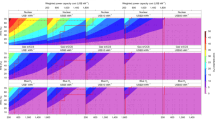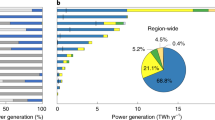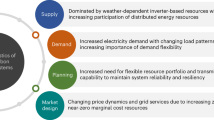Abstract
Enhanced geothermal systems (EGSs) are an emerging energy technology with the potential to greatly expand the viable resource base for geothermal power generation. Although EGSs have traditionally been envisioned as ‘baseload’ resources, flexible operation of EGS wellfields could allow these plants to provide load-following generation and long-duration energy storage. In this work we evaluate the impact of operational flexibility on the long-run system value and deployment potential of EGS power in the western United States. We find that load-following generation and in-reservoir energy storage enhance the role of EGS power in least-cost decarbonized electricity systems, substantially increasing optimal geothermal penetration and reducing bulk electricity supply costs compared to systems with inflexible EGSs or no EGSs. Flexible geothermal plants preferentially displace the most expensive competing resources by shifting their generation on diurnal and seasonal timescales, with round-trip energy storage efficiencies of 59–93%. Benefits of EGS flexibility are robust across a range of electricity market and geothermal technology development scenarios.
This is a preview of subscription content, access via your institution
Access options
Access Nature and 54 other Nature Portfolio journals
Get Nature+, our best-value online-access subscription
$29.99 / 30 days
cancel any time
Subscribe to this journal
Receive 12 digital issues and online access to articles
$119.00 per year
only $9.92 per issue
Buy this article
- Purchase on Springer Link
- Instant access to full article PDF
Prices may be subject to local taxes which are calculated during checkout







Similar content being viewed by others
Data availability
All GenX input and results datasets relevant to this study are available via Zenodo at https://doi.org/10.5281/zenodo.7023225 (ref. 49). Additional data are available from the corresponding author on reasonable request.
Code availability
The ResFrac reservoir simulation code is commercial software developed by the ResFrac Corporation. The GenX electricity system capacity expansion model is open source and available via GitHub at https://github.com/GenXProject/GenX. Source code for the modified version of GenX used in this work is available via Zenodo at https://doi.org/10.5281/zenodo.7023225 (ref. 49).
References
Sepulveda, N., Jenkins, J., de Sisternes, F. & Lester, R. The role of firm low-carbon electricity resources in deep decarbonization of power generation. Joule 2, 2403–2420 (2018).
Baik, E. et al. What is different about different net-zero carbon electricity systems? Energy Clim. Chang. 2, 100046 (2021).
Cole, W. J. et al. Quantifying the challenge of reaching a 100% renewable energy power system for the United States. Joule 5, 1732–1748 (2021).
Geothermal Technologies Office GeoVision: Harnessing the Heat Beneath Our Feet (US Department of Energy, 2019).
Annual Energy Outlook 2021 (US Energy Information Administration, 2021).
Williams, C., Reed, M., Mariner, R., DeAngelo, J. & Galanis, S. Assessment of Moderate- and High-Temperature Geothermal Resources of the United States Technical Report No. 2008-3082 (US Geological Survey, 2008).
The Future of Geothermal Energy Technical Report No. INL/EXT-06-11746 (Idaho National Laboratory, 2006).
Augustine, C., Fisher, S., Ho, J., Warren, I. & Witter, E. Enhanced Geothermal Shot Analysis for the Geothermal Technologies Office Technical Report No. NREL/TP-5700-84822 (National Renewable Energy Laboratory, 2023).
Cochran, J. & Denholm, P. The Los Angeles 100% Renewable Energy Study Technical Report No. NREL/TP-6A20-79444 (National Renewable Energy Laboratory, 2021).
Denholm, P. et al. Examining Supply-Side Options to Achieve 100% Clean Electricity by 2035 Technical Report No. NREL/TP6A40-81644 (National Renewable Energy Laboratory, 2022).
Matek, B. Flexible opportunities with geothermal technology: barriers and opportunities. Electr. J. 28, 45–51 (2015).
Jenkins, J. D., Luke, M. & Thernstrom, S. Getting to zero carbon emissions in the electric power sector. Joule 2, 2498–2510 (2018).
Larson, E. et al. Net-Zero America: Potential Pathways, Infrastructure, and Impacts (Princeton Univ., 2020).
Clack, C., Choukulkar, A., Coté, B. & McKee, S. A Plan for Economy-Wide Decarbonization of the United States (Vibrant Clean Energy, 2021).
Williams, J. H. et al. Carbon-neutral pathways for the United States. AGU Adv. 2, e2020AV000284 (2021).
Ricks, W., Norbeck, J. & Jenkins, J. The value of in-reservoir energy storage for flexible dispatch of geothermal power. Appl. Energy 313, 118807 (2022).
Jenkins, J. & Sepulveda, N. Enhanced Decision Support for a Changing Electricity Landscape: the GenX Configurable Electricity Resource Capacity Expansion Model Working Paper (MIT Energy Initiative, 2017).
GenX: a configurable power system capacity expansion model for studying low-carbon energy futures https://github.com/GenXProject/GenX (2022).
Blackwell, D. et al. Temperature-at-depth maps for the conterminous US and geothermal resource estimates. GRC Trans. 31, 1545–1550 (2011).
Lowry, T. S. et al. GeoVision Analysis Supporting Task Force Report: Reservoir Maintenance and Development Technical Report No. SAND2017-9977 (Sandia National Laboratories, 2017).
Mines, G. GETEM User Manual Technical Report No. INL/EXT-16-38751 (Idaho National Laboratories, 2016).
Michaelides, E. & Michaelides, D. The effect of ambient temperature fluctuation on the performance of geothermal power plants. Int. J. Exergy 8, 86–98 (2011).
2021 Annual Technology Baseline (National Renewable Energy Laboratory, 2021).
Manning, C. E. & Ingebritsen, S. Permeability of the continental crust: implications of geothermal data and metamorphic systems. Rev. Geophys. 37, 127–150 (1999).
Way, R., Ives, M., Mealy, P. & Farmer, J. Empirically grounded technology forecasts and the energy transition. Joule 6, 2057–2082 (2022).
Malhotra, A. & Schmidt, T. S. Accelerating low-carbon innovation. Joule 4, 2259–2267 (2020).
Latimer, T. & Meier, P. Use of the experience curve to understand economics for at-scale EGS projects. In Proceedings of the 42nd Workshop on Geothermal Reservoir Engineering 768–776 (Stanford Geothermal Program, Stanford, CA, 2017).
Rutqvist, J. et al. Coupled process analysis of flexible geothermal production from steam- and liquid-dominated systems: impact on wells. In Proceedings of the 45th Workshop on Geothermal Reservoir Engineering 287–303 (Stanford Geothermal Program, Stanford, CA, 2020).
Rutqvist, J., Pan, L., Dobson, P., Zhou, Q. & Hu, M. Coupled process analysis of flexible geothermal production from a liquid-dominated system: impact on wells. In Proceedings of the World Geothermal Congress 2020+1 (Reykjavik, Iceland, 2021).
Pollack, A., Horne, R. & Mukerji, T. What are the challenges in developing enhanced geothermal systems (EGS)? Observations from 64 EGS sites. In Proceedings of the World Geothermal Congress 2020+1 (Reykjavik, Iceland, 2021).
Augustine, C. A methodology for calculating EGS electricity generation potential based on the Gringarten model for heat extraction from fractured rock. GRC Trans. 40, 679–687 (2016).
Sepulveda, N., Jenkins, J., Edington, A., Mallapragada, D. S. & Lester, R. The design space for long-duration energy storage in decarbonized power systems. Nat. Energy 6, 506–516 (2021).
Viswanathan, V. et al. 2022 Grid Energy Storage Technology Cost and Performance Assessment Technical Report No. PNNL-33283 (Pacific Northwest National Lab, 2022).
Lovering, J., Swain, M., Blomqvist, L. & Hernandez, R. R. Land-use intensity of electricity production and tomorrow’s energy landscape. PLoS ONE 17, e0270155 (2022).
Haelg, L., Waelchli, M. & Schmidt, T. S. Supporting energy technology deployment while avoiding unintended technological lock-in: a policy design perspective. Environ. Res. Lett. 13, 104011 (2018).
Baillieux, P. Multidisciplinary Approach to Understand the Localization of Geothermal Anomalies in the Upper Rhine Grabel From Regional to Local Scale. PhD thesis, University of Neuchatel (2013).
Huang, S. Geothermal energy in China. Nat. Clim. Chang. 2, 557–560 (2012).
Grasby, S. et al. Geothermal Energy Resource Potential of Canada (Geological Survey of Canada, 2012).
Mai, T. et al. Electrification Futures Study: Scenarios of Electric Technology Adoption and Power Consumption in the United States Technical Report No. NREL/TP-6A20-71500 (National Renewable Energy Laboratory, 2018).
Schivley, G. et al. PowerGenome/PowerGenome v.0.5.4 (2022); https://doi.org/10.5281/zenodo.6092712
McClure, M., Kang, C., Hewson, C. & Medam, S. ResFrac Technical Writeup (ResFrac Corporation, 2021).
Norbeck, J. & Latimer, T. Commercial-scale demonstration of a first-of-a-kind enhanced geothermal system. Preprint at https://doi.org/10.31223/X52X0B (2023).
Dupriest, F. & Noynaert, S. Drilling practices and workflows for geothermal operations. In SPE/IADC Drilling Conference and Exhibition https://doi.org/10.2118/208798-MS (Galveston, TX, 2022).
Utah FORGE is excited to announce the successful completion of the three-stage hydraulic stimulation of its first highly deviated injection well, 16A(78)-32. Utah FORGE, US Department of Energy https://utahforge.com/2022/04/27/utah-forge-wraps-up-a-3-stage-hydraulic-stimulation-of-well-16a78-32/ (2022).
Jenkins, J. D. et al. Preliminary Report: The Climate and Energy Impacts of the Inflation Reduction Act of 2022 (REPEAT Project, 2022).
Karadas, M., Celik, H. M., Serpen, U. & Toksoy, M. Multiple regression analysis of performance parameters of a binary cycle geothermal power plant. Geothermics 54, 68–75 (2015).
Hourly/Sub-Hourly Observational Data Version 3.0.0 (National Oceanic and Atmospheric Administration, National Centers for Environmental Information, 2021); Accessed February 2, 2022 at https://www.ncei.noaa.gov/maps/hourly/
McLean, M. L. & Espinoza, D. N. Thermal destressing: implications for short-circuiting in enhanced geothermal systems. Renew. Energy 202, 736–755 (2023).
Ricks, W., Voller, K., Galban, G., Norbeck, J. H. & Jenkins, J. D. The role of flexible geothermal power in decarbonized electricity systems: supplementary data. Zenodo https://doi.org/10.5281/zenodo.7023225 (2022).
Acknowledgements
This work was supported by the US Department of Energy, Office of Science Small Business Innovation Research (SBIR) programme under award no. DE-SC0020823 (W.R., J.D.J., J.H.N., K.V. and G.G.) and by Princeton University’s Zero-Carbon Technology Consortium, which is funded by gifts from Breakthrough Energy, ClearPath, GE and Google (W.R. and J.D.J.).
Author information
Authors and Affiliations
Contributions
W.R., J.D.J. and J.H.N. conceptualized the study. W.R. and J.D.J. developed the experimental design. K.V. and G.G. designed and performed the geothermal reservoir simulations. W.R. developed the optimization model, geothermal supply curves and other input datasets. W.R. performed the formal analysis, visualization and investigation, and produced the figures. W.R. draughted, revised and finalized the manuscript. J.D.J. and J.H.N. advised on the analysis and reviewed and revised the manuscript.
Corresponding author
Ethics declarations
Competing interests
K.V., G.G. and J.H.N. are employees of Fervo Energy, a geothermal energy development company. J.D.J. is part owner of DeSolve, LLC, which provides techno-economic analysis and decision support for clean energy technology ventures and investors. Clients within the last 12 months include Radia Inc. and Rice Acquisition Corp II (now doing business as NET Power Inc.). He serves on the advisory boards of Eavor Technologies Inc., a closed-loop geothermal technology company, and Rondo Energy, a provider of high-temperature thermal energy storage and industrial decarbonization solutions, and has an equity interest in both companies. He also provides policy advisory services to Clean Air Task Force, a non-profit environmental advocacy group, and serves as a technical advisor to MUUS Climate Partners and Energy Impact Partners, both investors in early-stage climate technology companies. W.R. has performed consulting work for Isometric, a carbon removal standard and registry.
Peer review
Peer review information
Nature Energy thanks Jonathan Ho, Dev Millstein and the other, anonymous, reviewer(s) for their contribution to the peer review of this work.
Additional information
Publisher’s note Springer Nature remains neutral with regard to jurisdictional claims in published maps and institutional affiliations.
Supplementary information
Supplementary Information
Supplementary Tables 1–10, Figs. 1–38 and Notes 1–7.
Rights and permissions
Springer Nature or its licensor (e.g. a society or other partner) holds exclusive rights to this article under a publishing agreement with the author(s) or other rightsholder(s); author self-archiving of the accepted manuscript version of this article is solely governed by the terms of such publishing agreement and applicable law.
About this article
Cite this article
Ricks, W., Voller, K., Galban, G. et al. The role of flexible geothermal power in decarbonized electricity systems. Nat Energy (2024). https://doi.org/10.1038/s41560-023-01437-y
Received:
Accepted:
Published:
DOI: https://doi.org/10.1038/s41560-023-01437-y



